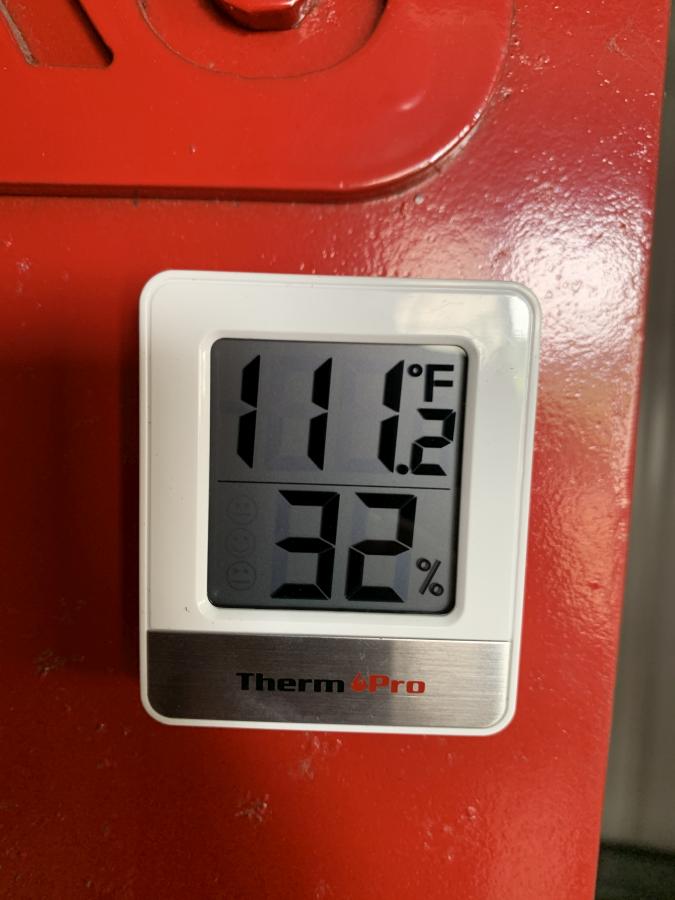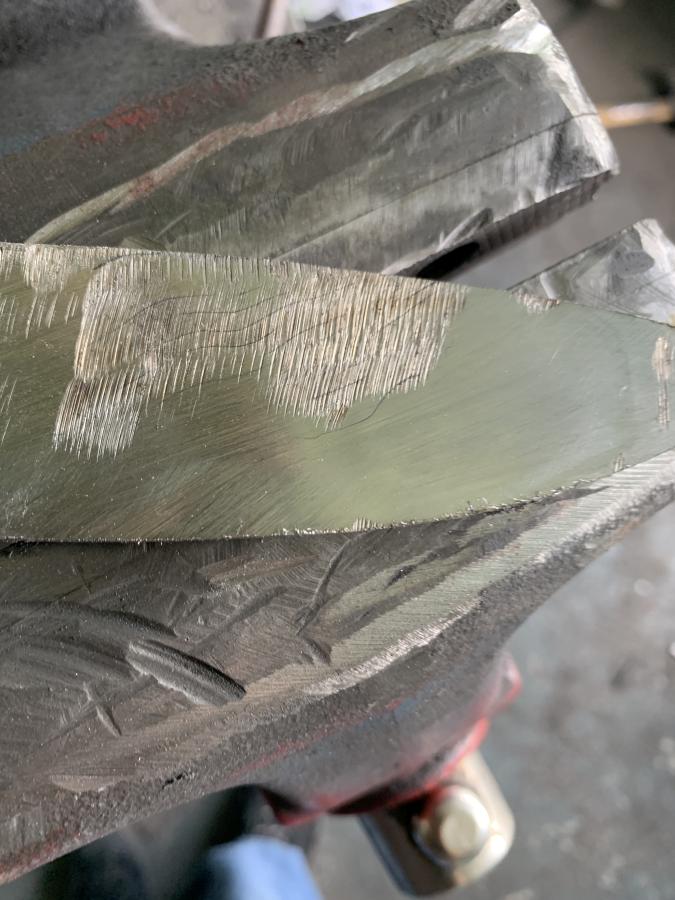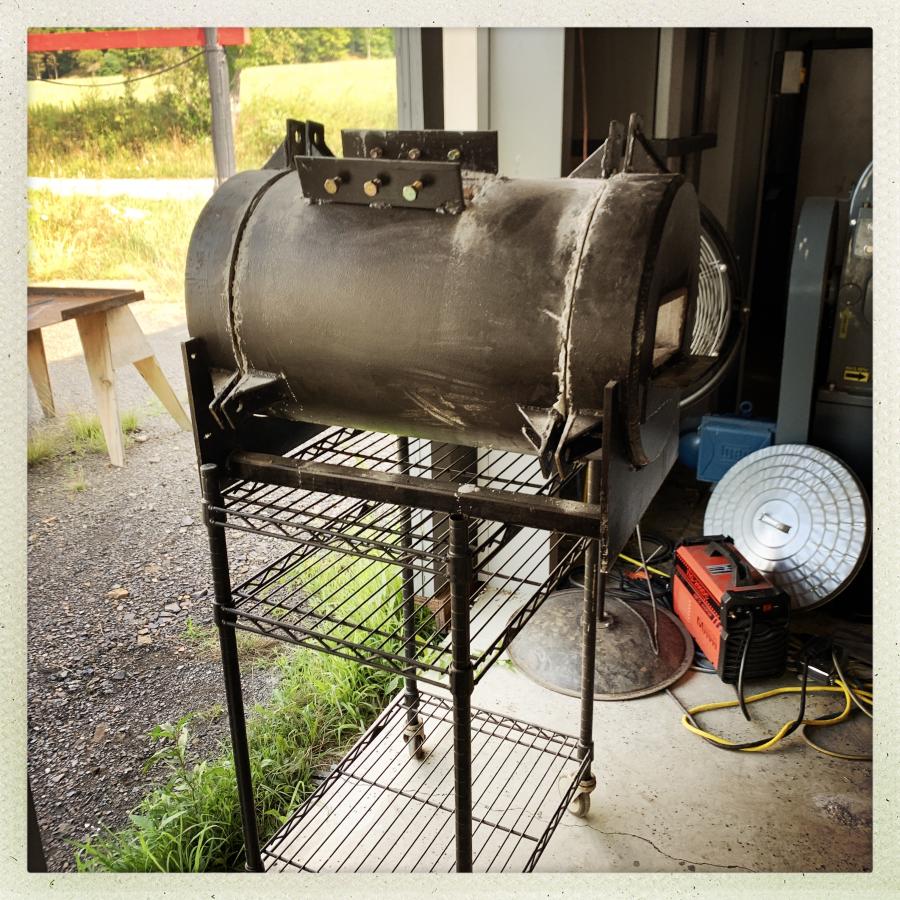Monday, I set myself on fire. It wasn’t too bad, but it was definitely not any kind of good. My face felt sunburned for a couple days, and my mustache was all crispy. My eyebrows are still OK, along with my eyeballs, but my bangs are gone. I got my arm up and covered my face (put it out) pretty fast.
I’ve been dealing with this problem with the monster forge: thermal mass. Basically, I made it too big and heavy. Heating all that cement and steel takes too long and there appears to be a maximum in effect – if I had a smaller cavity with better insulation I’d expect to hit welding temperature pretty quickly, but the monster forge just gets very hot and stays there. One problem, I think, is that the fan is blowing cool air in, which is not helpful. But the pressurized air architecture results in cooling, although the propane burns well, and the effect of a “thermal death beam is significant. Standing anywhere near the forge opening doesn’t just get hot, it sets you on fire. That kinda sucks. My old Chili forge made welding temperature easily, but only put out enough waste heat that it went straight up and didn’t bother me.

With an ambient temperature around 111F, I was sweating off gallons of water, even though I was standing in front of a fan blowing cool air in from the outside. That was – unacceptable. There are possible health consequences in additional to “set self on fire” which was a concern. I was having no damn fun at all trying to reach in and grab things in all that heat. The smell of “overheated welding mitts” is a warning.

Here’s what happens to a stack of twist damascus when the welds on the twist don’t take. You can’t grind past them because they’re pretty deep. If you have a bar of twist up around welding temperature, those parting-lines don’t happen – they just weld shut from the pressure of the twisting. So, basically what you’re looking at, above, is a bar of garbage. Some of it’s OK but some of it’s not and no bladesmith in their right mind is going to bother figuring that out. Into the bin with it.

Then there was the wire rope test. That “bar” looks bar-ish but it’s not. If you whack it on the anvil when it’s cold, it makes a dull thwack instead of a ping. That is not a good sign, at all.
What to do?
Option 1: continue f’ing around with the monster forge, trying to get a few hundred degrees more heat
Option 2: get a smaller forge like my old Chili forge, and stop fighting the situation
I called the folks at Chili, and they’re going to be pushing a bunch out the door in September and now I’m on the list and I can get back to doing worthwhile stuff instead of messing with the monster. An important part of succeeding at things is knowing when you’ve failed, so you can pursue another angle of attack. It’s weird how some gear shifted in my mind and I started looking at the monster forge and thinking “uh nope. Too much thermal mass.” While I was building it, I did have a little voice in the back of my mind going “too much thermal mass?” the whole time and it appears that was right. When I look at what succeeds it’s:
1) Small inner cavity
2) Good insulation with lots of kaowool
3) minimal use of cement
4) venturi burners work fine and are not as noisy
5) venturi burners are safer because there is no issue of mixed air/gas hanging out in the feed lines waiting to explode in your face
I’m mad at myself for going too far over the top, but that’s one of the inherent disadvantages of being me: I tend to do that. If you’re a person who does that, you probably understand that sometimes it’s a cost of doing business that you need to amortize and move on from.

So, what to do with a 300-lb paperweight? Well, I had some practice moving it from before, so I lifted it with a come-along, lowered it to my wheeled shop cart, and pushed it to the door. Then, it fell over. Wisely, I got the hell away from it and all it did was make a big THUNK. It’s the kind of thing that would do serious damage; I was wearing steel-toed boots for the occasion, but I was able to dance out of the way. By the way, a bit of advice regarding moving heavy things: always plan your escape-route. Keep it updated as you move. You don’t want to find your path blocked and get crushed against something. In fact, I completely cleared the whole area so I could back up my pickup truck and also get out of the way of anything falling. When it fell, I put a tow strap over an I-beam in the building’s frame, lifted it about 4 feet, and gently lowered it into the truck bed.
Then, it was off to Novey’s scrap-yard, where you can get $5 for a chunk of steel that big. I didn’t care about the fiver, I just never wanted to see the thing again. Noveys is an interesting place, but I really didn’t feel like hanging around. Me and a guy who works there threw the forge body into a pile of other broken imaginings.
Related/unrelated, I have a big piece of steel plate that I’ve been using as a welding table and practice piece. I’ve gotten fairly OK with that stainless flux-rod, and now I can write letters in stainless steel on other metals. The left lines are a bit wobbly, I know, but it is what it is.


Sad to see the monster go. That is hard to let go of an idea, but glad you could, and wow, five bucks?? Maybe they didn’t like all that cement.
Your “M” reminds me of a cattle brand.
Hope the new one arrives quickly!
Well, it set you on fire first, so I think it deserved its trip to the scrapyard. How disappointing after all your work, but safety is more important.
The hot spots and cold spots are just going to waste your time and materials, so I’m glad you’ve opted for cutting your losses. I’m sure dumping it felt like a bit of revenge. HA, evil contraption, begone from my sight!!
Don’t throw it away, convert it into a smoker. The price of brisket is bound to come down eventually.
Based on the amount of heat it generates, it probably would work very well at getting rid of bodies.
I mean, left-overs
Can I refer you to my previous comment about counter-flow heat exchangers? I mean, if you’re building it yourself it’s probably a lot of work (but you might be able to buy in major parts of the solution ready-made), but it seems like it would solve that (as well as reduce the fuel requirements.)
Don’t feel too bad about having to iterate a design. Some parts that I’ve designed like resin injectors have gone through several generations befor I landed on a design that is good enough. And every design is a compromise.
What puzzles me about these kinds of forges is why they have no chimney like the blacksmith forges of old? If you’re pushing in a lot of gas and air to create heat, the hot combustion gases need someplace to go. If the largest opening is where you put the metal pieces in, then it stands to reason at that place most of the hot gas will come out. If you have a chimney the hot gasses have an alternative path instead of “in your face”. It is also pretty easy to build in a heat-exchanger to pre-heat the combustion air into a chimney. That should improve efficiency significantly.
Ah, that sucks having to throw away something you have worked so hard to make. I hate that and I am susceptible to sunk cost fallacy and if I need to cut my losses, it tends to drag out for a long time – I usually have to put things aside for a while and only then I am mentally able to toss them.
I have an opposite problem to yours, my forge is too small for my burner, so I waste a lot of heat because it simply escapes. And I cannot harden bigger blades, like machetes.
@rsmith, I was wondering the same thing as you, that is why my forge actually does have a hole for the hot gasses to escape. It does reduce the amount of flames that come out at the front where I put stuff in.
xohjoh2n@#5:
Can I refer you to my previous comment about counter-flow heat exchangers?
I remember that comment; I can find it again. The first time I saw it I decided to let it fly right over my head because I’d never do anything that fancy…
Reginald Selkirk@#3:
Don’t throw it away, convert it into a smoker.
I already have a smoker!
It’s already at the scrap yard, which means it has probably been chopped up with a torch.
rsmith@#6:
What puzzles me about these kinds of forges is why they have no chimney like the blacksmith forges of old? If you’re pushing in a lot of gas and air to create heat, the hot combustion gases need someplace to go
Usually, you want it to swirl around in the forge cavity and transfer a lot of heat. And there’s more coming down the pipe. The old blacksmith forges are burning coal and you really need a chimney for those or you wind up with a case of black lung.
This is useful for me however, as i’m planning something similar. Though a bit narrower. I was pondering a ribbon burner, but i might take your advice and just use a few venturi burners.
What were your interior dimensions?
@dangerousbeans:
I used 16″ 3/8 thick pipe and the interior came out about 10″ x 10″ x 12″(L). Way too big it turns out.
The ribbon burner was interesting but the exhaust heat was a showstopper. Venturis seem to deposit the heat where you want it to stay.
It also helps that I can buy the venturis, while I have to make the ribbon burner. Multiple venturis are also easier to switch independently.
So that’s a 100 square inch cross section, i was thinking more like 8×5 or 6×5. I’m mostly after more length (insert inappropriate joke here)
The “mr volcano” forges on amazon are sort of like the VW beetle of forge design. It’s really solid. I wish I had gone the simple route, but that is usually not my way.
Currently setting one of them up. I drilled a hole near the top and inserted an alumina thermocouple protector. I’m down to painting the interior with satanite. The thermocouple/readout is pretty amazingly fun: light the forge and it goes from ambient to 600F in 5 seconds. Whee!